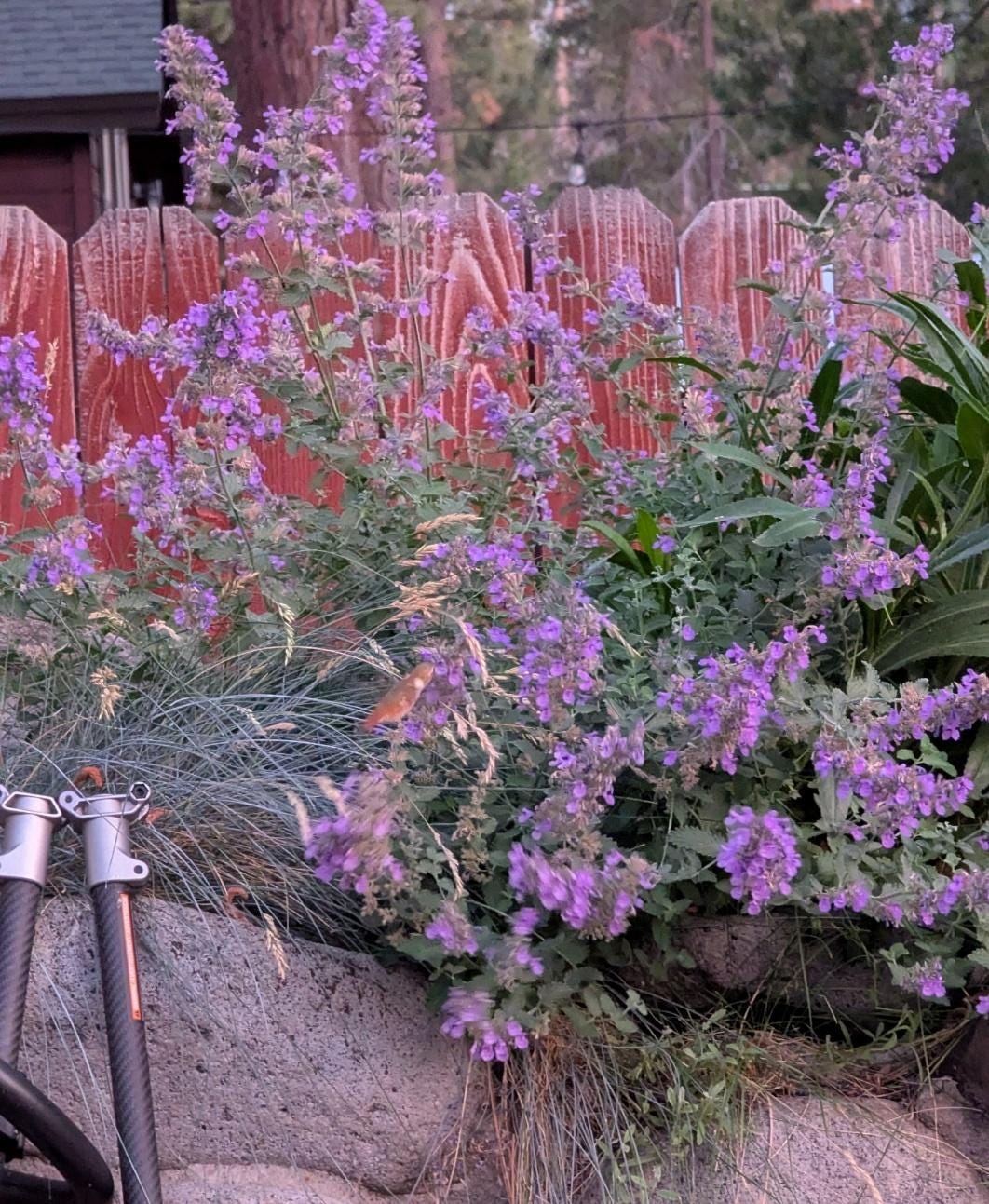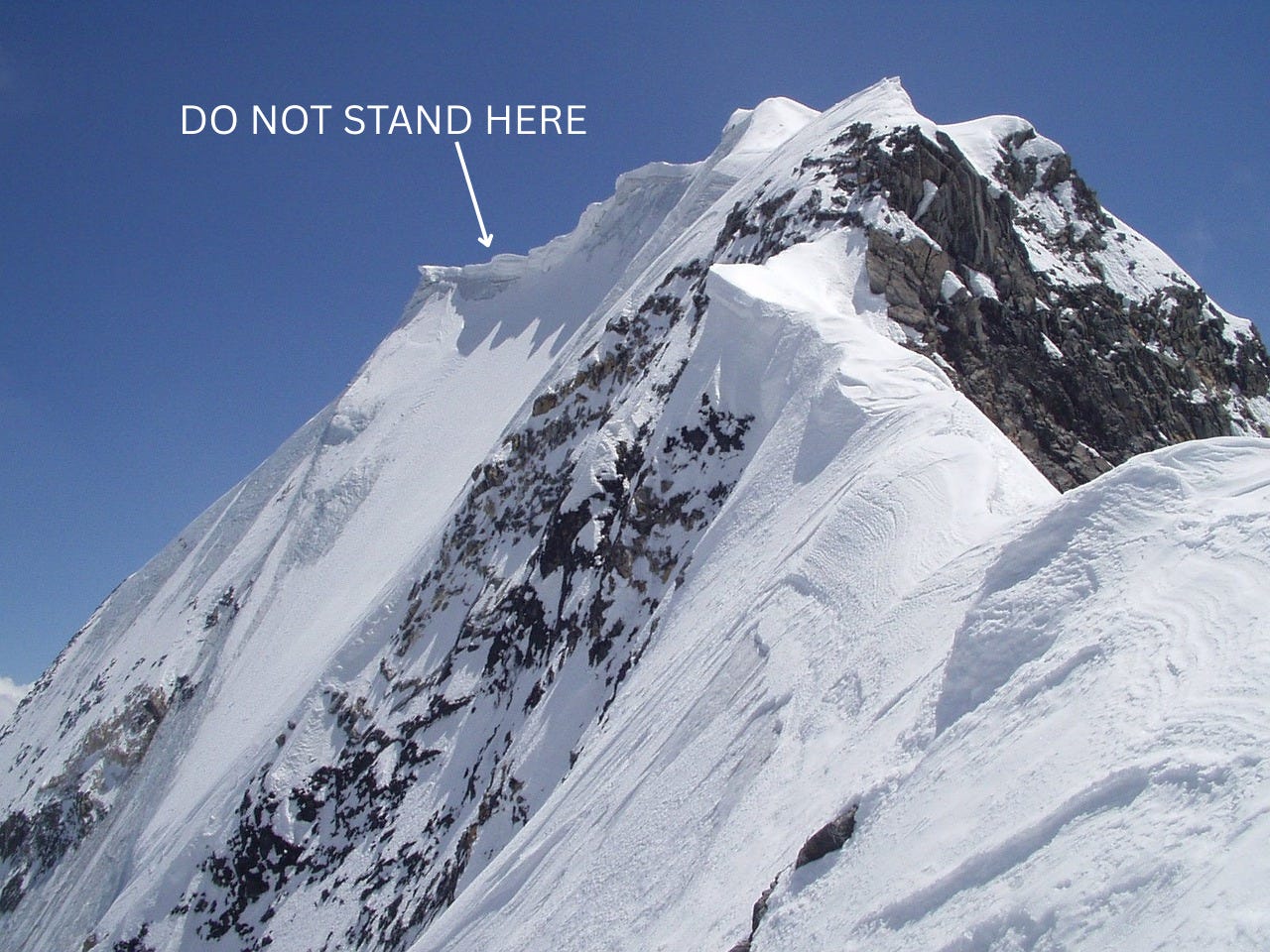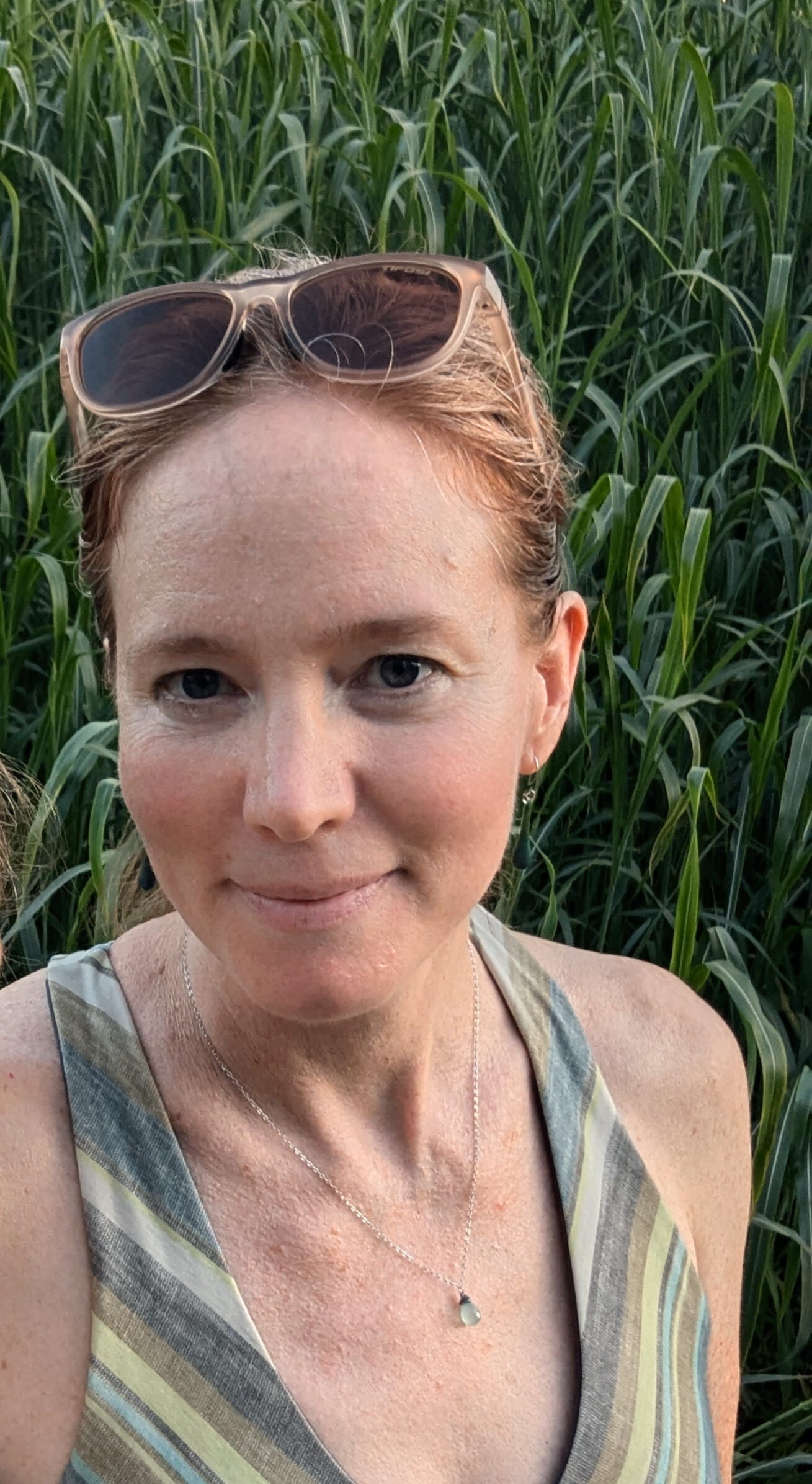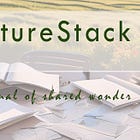🍃 Reciprocity: the interview
6 questions for Amanda Royal
Nature writer, n. A person who delights in paying attention, being astonished, and telling about it.1
“Environmental restoration is happening every day. I want to highlight the people who are overcoming incredible obstacles to save the places they love. I write to show readers that not only can they make a small difference, and small differences add up to big differences, but that sometimes, just one person can make an enormous difference. ” ~ Amanda Royal
Welcome to Season 2 of the Reciprocity interviews. My inbox is full of treasure in the form of lovingly observed writing about place, encounters both wild and gentle, imaginative kinship and renewed reciprocity. These thoughtful, talented writers kindled in me the desire to learn more about them.
Today’s guest,
describes herself as an investigator of hope and a centrist collector of solutions.2 A former newspaper reporter and current eco-news junkie, she’s received two Nevada Press Association awards for environment reporting and an honorable mention from The Associated Press.I’m overjoyed that her newsletter reaches so many subscribers already. Environmental success stories are empowering, while too much doom-n-gloom can be paralyzing. In her series, “Hopeful Headlines,” and even when she tackles bad news, she has an eye for meaningful ways to be of service. Witness these headlines:
“Los Angeles fires are a climate disaster. Here’s what we can do.”3
“Historic agreement affirms tribe’s right to set good fire.”4
“Whales rebound near New York because of a fish nobody will name: Menhaden.”5
Amanda’s newsletter, Earth Hope, is a solutions-based journalism project that highlights environmental success stories to inspire action.6
Why are you drawn to nature writing?
I’m obsessed with how headlines are affecting people’s engagement with important environmental issues. We’re living with toxic levels of negative headlines, and we’ve become unwitting slaves to algorithms that profit off of outrage. We can’t constantly “raise the alarm” or we risk issue fatigue. More conservationists and scientists are calling for messages of hope and solutions.
Some people come at this topic from a science, education, or conservation background. I come from a journalism background, with an insider’s knowledge of how newsrooms work, and how often reporters’ stories are rejected because they didn’t include an argumentative quote or contrarian point of view. Legacy media is built on the conflict-based news model.
I came here to experiment with the idea that I could write solutions-based news that emphasizes environmental success stories to lure people back to these topics and inspire action. I’m thrilled that this message has resonated with so many readers.
How does writing about nature affect you, in your work or personal life?
Writing on Substack has unleashed me from all the habits I learned in old-school newsrooms. Don’t editorialize. Don’t use first person. Don’t file a story without an argument between two sources. Ugh, it was exhausting. Substack provides permission to venture into the weird, psychedelic, poetic, or spiritual.
It took a while to untrain my neurons and allow myself to write with some extravagance. To add color, sensuality, emotion, rather than always pare down stories down to just the facts. I think of nature writing as memoir fused with the truth and beauty of nature.7
When a reader says, “Thank you, I needed to hear that today,” it feels like I’ve accomplished something. I’ve held their hand for a moment and they may pass it along somehow in their own life. It’s amazing that this is happening online, where so much division is going on. But that’s what we need more of right now: to be connected and to be connections. We must editorialize, personalize, and knock readers over with flesh and blood experience.
While outside, have you ever experienced feeling small, lost or in danger?
Yes, yes, and yes.
I spent much of my twenties and thirties as an adrenaline junkie pursuing dangerous activities outdoors like skiing and mountaineering. Rock climbing can be defined as staring at a slab of rock six inches from your face while pinned on a cliff several hundred feet in the air, contemplating your own possible death for four to eight hours in a row. The addiction to rock climbing comes from achieving a meditative peace with your own fear, a transcendence of sorts that’s similar to being “in the zone” while writing.
The lessons nature teaches us are rarely vague.
Once, while skiing between two mountains in the backcountry, some friends and I stopped to admire the view of Lake Tahoe. Five of us paused in a saddle above a granite cliff. We knew not to approach the edge, because that wind-blown lip of snow, called a cornice, hovers over air. While the others exchanged gleeful comments and pointed out various peaks in the distance, I looked down and noticed a hairline crack in the snow right between my skis. Puzzled, I urged everyone to move on. I remember looking back at my friend Scotty, who was lingering far too long, perhaps taking a picture. I called again for him to come. I can play the scene like a movie in my mind. Scotty took a few steps toward us and, as if he’d kicked it off, the cornice gave way right behind him — where I’d just been standing — a piece of snow the size of a school bus. Crack. That instantaneous break erupted into a loud thunder as that enormous piece of snow tumbled down the mountain, without me or anyone I love in tow. Why did I look down at my skis that day, instead of at the view?
On being lost:
I have a terrible sense of direction, so I’m always lost. I hang out with people who have good direction to decrease the hazards of this condition.
To me, the most poignant moments we have in life are when we’re feeling lost and directionless and nature finds us. I was recently sitting on the back porch of a house in the mountains with a garden the homeowner had nurtured to be beneficial to insects and animals. The sun was setting and there was a pink glow resting on all the flowers in the yard: yarrow, columbine, fireweed, Shasta daisy, and brown-eyed susans. The purple catmint and red bee balm were particularly attractive to a few bumblebees and a tiny rufous hummingbird that came and went many times. Then small bats, their wing beats so silent, began to flutter high and low all around me. Whatever I was worrying about drifted away on their soft wings. And behind them, the first star began to sparkle. Every cell of my body hummed with peace, and I thought, “We have the power to create this anywhere.” There’s always an embrace that nature will give you, should you be willing to step outside and listen and accept its arms around you.
What’s a favorite memory of nature from your childhood?
I spent my youngest years in China,8 and my elementary school years on the island of Oahu in Hawaii, which was nothing short of magical. I was free-range and spent much time collecting grasshoppers, beetles, snails, and tadpoles. I once collected a large jar of grasshoppers from the field next to our house in China and then let them all go in our screened-in front entryway. The mayhem of 100 freed grasshoppers filled my four-year-old soul with delight. I’m not sure how the adults took it, since they had to capture them all. I was always told that I was a mischievous and precocious kid, but I think these were just the beginnings of a nature-curious mind.
I rode a pink Huffy bike with a giant banana seat in Hawaii. I cooked my own ramen noodles anytime I was hungry. The sun set at the same time every day and we were expected to be home before dark. We swam in the ocean several times a week with our parents. I was pummeled by waves while boogie boarding, face smashed into the seafloor, scooping up sand with my nose and chin. I learned deep respect for the ocean and any body of water. In trying times that seem to last forever, I picture myself in a wave and know that air is just moments away.
What do you hope for, for your writing?
I write to inspire action. The planet cannot afford for the most educated and wealthy people living on it to be depressed. I want readers to know that solutions are implemented every day by millions of people. Environmental restoration is happening every day. I want to highlight the people who are overcoming incredible obstacles to save the places they love. I write to show readers that not only can they make a small difference, and small differences add up to big differences, but that sometimes, just one person can make an enormous difference.
I don’t write to give people a break from the bad news. We do need to consume all varieties of news. But we must remember that solutions exist. In this moment of planetary problems, we need fortitude and to “not beat our heads against the wall, but move through the wall,” as the ecologist Roland Knapp said in my story about saving Yosemite’s frogs.9
A writer or other creative artist who makes you hopeful for humanity and the earth.
This is a hard question. It’s too difficult to pick just one! I’m drawn to survivors who are building beauty from the wreckage of immense pain, who weave tales of nature with love, sensuality, hope, loss, mystery, and redemption.10
My number one book recommendation is Suzanne Simard’s Finding the Mother Tree, which blends science, memoir, and nature writing incredibly well. Since I’m a mother and woman, I empathize with many of Simard’s struggles. She’s a forest ecologist who was at the vanguard of proving that plants in a forest live symbiotically, not in competition, and she suffered in many predictable and unpredictable ways as a result. I cried for many hours!
My number one Substack recommendation is ’s The Weekly Anthropocene, for his unbridled enthusiasm for humanity’s progress. No pain or trauma here. Start with his interview of the man moving forests in Mexico to save monarch butterflies.11
Ceaselessly creative storyteller, photographer and abuse survivor . “Landing on that new runway” and “Known by the company you keep” are bookends on a gentle soul’s survival tale.12
The novel Where the Crawdads Sing, by Delia Owens. Plugging David E. Perry again; his serialized memoir on Substack, Raisin’ Up Catfish, reminds me of Crawdads. Both books are coming-of-age stories that take place in the American South. (After China and Hawaii, I grew up in the South). Aside from the loneliness that many of the 12 million readers of Crawdads related to, Owens creates a profound sense of place and a gutting sense of loss surrounding the development of the tidal marshlands of North Carolina, whose bounty of mussels and fish the young protagonist depends on. David, likewise, in his Catfish narratives, with unfiltered words and incredible photography, always transports readers into a unique time and place, complete with smells and sights, salacious and lonely thoughts, always with a powerful undercurrent of pain, longing, and beauty intertwined.
Distance runner and leukemia survivor , “Of Time and Rebellion.”13
TBI survivor, birder, law student, and photographer , “Everything can be trained.”14
Nature writer . Bryan’s Chasing Nature website includes an entire category called “Sex” that is filled with similarly intriguing headlines. That’s the kind of thing we need right now, when environmentalists have a reputation, justified or not, for being nerdy, boring, preachy, and prudish.15
’s “In Touch” series about rare California species reminds us that unique plants and animals are often hiding right before our eyes. We don’t need to travel to the Galapagos to see endangered species!16
Ecologist and river advocate , working to bring science out of the ivory tower. He often compares biodiversity to a diversified stock portfolio. Both safeguard against shocks to the entire system. We need more relatable analogies like this! See “Diversity is the spice of life” and “Don’t forget non-forest carbon-rich ecosystems!”17
an erotic poet who often interweaves moments in nature, check out “Moonlit Wave.”18
is a “haunted hiker” who writes about dead salmon, portals, ghosts, bog creatures, and haunted houses: “please stay out of the swamp.”19
Eager: The Surprising Secret Life of Beavers and Why They Matter, By Ben Goldfarb. Beavers could save this planet!
Salt and Cod by Mark Kurlansky, how environment influences history.20
1491 by Charles Mann. Mounting evidence that tens of millions of Native Americans lived on these continents before colonization, building advanced civilizations with agriculture, fire-shaped landscapes, and progressive thought that influenced Enlightenment thinkers.21
The Pyrocene and Pyrocene Park by Stephen Pyne. More prescribed fire now!22
Each season, we donate 30% of paid subscriptions to a worthy environmental cause. This season, it’s Indigenous Climate Action. They envision a world with sovereign and thriving Indigenous Peoples and cultures leading climate justice for all. Track past and current recipients here.
What did you enjoy most about this interview? We’d love to hear from you. Or share it with others by restacking on Notes, via the Substack app. Thanks!
Notes and links
If you’d like to participate in this interview series, please DM me on chat, or reach out via email: gabrielli-dot-julie-at-gmail. Find previous interviews here.
For more inspired nature writing and artwork from the best of Substack, check out the articles in our final edition of NatureStack journal.
In further service to Substack’s nature writers,
curates this lovely directory of nature-focused writers:thanks, Mary Oliver
Which is how I would describe myself, if I had her gift of concision. The original name of my newsletter was Building Hope, after all.
From January, 2025, read it here
From March, 2025, read it here
From August, 2025, read it here
A patient new friend” is Amanda’s best attempt at this type of writing, perhaps, and lives in the personal narratives section of her site.
“On President Carter, China and my family,” read it here
“The ecologist who dared love Yosemite’s frogs,” read it here
Editor’s note: Amanda, aware that her responses may push this post past the usual easy-browsing length, invited me to edit as I see fit. I considered cutting some of these, but in the end, decided to share it all. Happy browsing!
“Interview with Dr. Cuauhtémoc Sáenz-Romero, Sacred Fir Forest Mover,” read it here
Editor’s note: I’ve read Salt, and agree it’s fascinating.
Chiming in again: 1491 is a fabulous book, one of those I wish everyone would read.
Okay, last time, I promise. . . Heard Dr. Pyne interviewed and it rocked my world. This guy needs to be more well-known.











Loved this entire interview. And this: “The planet cannot afford for the most educated and wealthy people living on it to be depressed.” Yup!
This interview was great! And thanks to Amanda for recommending me. I love so many of these writers already and am looking forward to getting to know the rest!
Amanda - that terrifying snow skiing story got me - holy bananas!!
Julie - so nice to meet you and thank you for featuring Amanda. I recommend her substack more than any other! I love what you say about hope making us feel empowered. That is always how I feel when I finish reading her work. Amazing interview.